The MGA With An Attitude
ROLLER RELEASE BEARING - CT-210
The graphite release bearing is cheap and generally durable, will usually last as long as a friction disc (as long as you don't ride with your foot on the clutch pedal), so there is not much benefit to paying more for a special (non-standard) part. Also some roller release bearings have been very unreliable, sometimes not lasting 1000 miles. The plastic bodied parts we notoriously bad, but that's not the only reason.
The hydraulic clutch is returned only by force of the springs in the pressure plate. The release bearing will stay in gentle contact with the pressure plate, so a roller bearing may continue to spin all the time, leading to premature failure. To make it last longer it needs a return spring on the release arm to pull the bearing away from the pressure plate. Then it needs an adjustable back stop to keep the bearing from withdrawing too far. As clutch parts wear the thing will go out of adjustment, leading to the need for regular inspection and periodic adjustment of the back stop.
All things considered, IMHO a roller release bearing is more bother than benefit. The original type graphite release bearing seems to work well. Until you can figure out how to make the rest of the clutch and the gearbox last way beyond 100,000 miles, if it ain't broke don't fix it.
$.02 from a bloke who has driven MGA a quarter million miles with standard release bearings.
On April 5, 2013, Hap Waldrop in Greenville, SC, USA wrote:
"I stumbled across this a while back through some part horse trading. It makes me feel a bit more warm, and fuzzy because it has the steel housing like the OEM carbon ones, and the roller bearing itself has what looks like to be Teflon contact surface, and maybe a higher quality roller bearing".

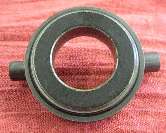
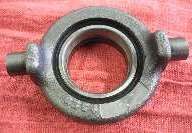
 [Current source for this bearing is not known]. [Current source for this bearing is not known].
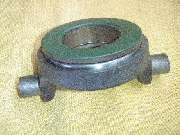
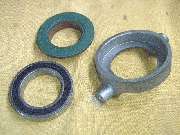
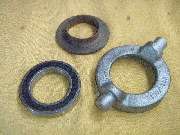
This one (with Teflon front face) is currently (March 2014) being sold through eBay.
 British Automotive makes a "Stop Kit" for MGA and MGB hydraulic clutch. This kit adds a return spring and an adjustable mechanical stop for the clutch release lever. The idea is for the spring to pull the release bearing back a bit to prevent pressure contact with the pressure plate release pad, and for the mechanical stop to prevent too much retraction of the hydraulic slave cylinder.
British Automotive makes a "Stop Kit" for MGA and MGB hydraulic clutch. This kit adds a return spring and an adjustable mechanical stop for the clutch release lever. The idea is for the spring to pull the release bearing back a bit to prevent pressure contact with the pressure plate release pad, and for the mechanical stop to prevent too much retraction of the hydraulic slave cylinder.
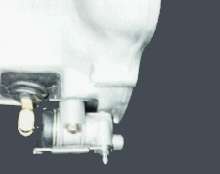
The metal stop plate is trapped between the slave cylinder and bellhousing. Loosen the slave cylinder mounting bolts to adjust position of the stop plate. The special pushrod has a side bracket to accept the return spring. Opposite end of the return spring hooks onto the bleed nipple.
There are at least 2 (maybe 3) roller release bearings on the market. There's a Moss version, a "plain white box" version, and an AP version that comes in the blue AP box. That's the one that comes in the Borg and Beck heavy duty clutch kit.
|







